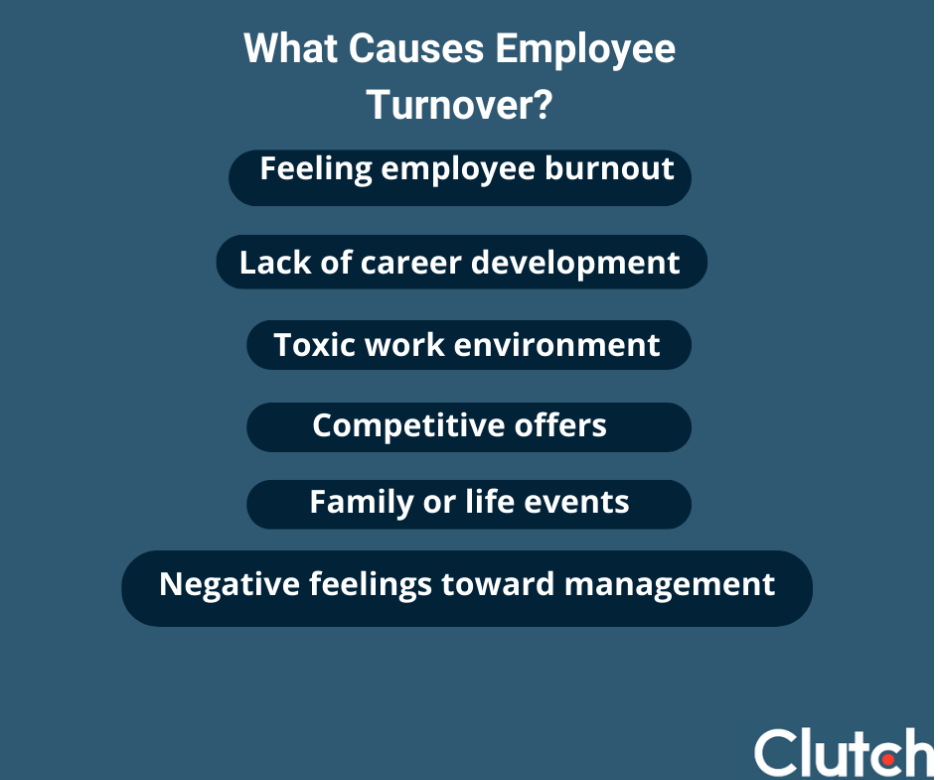

Updated January 2, 2025
Delivering the best employee experience is key to employee retention. This article explores how companies can prevent employee turnover with a few key strategies.
With the prolonged COVID-19 pandemic and the likelihood of a recession, high turnover rates are plaguing all industries. Employees come and go, but it can be costly for businesses, so businesses should reduce their turnover rates as much as possible.
With these employee turnover rates, many individuals are looking for new jobs that deliver the perfect work-life balance.
Looking for a Human Resources agency?
Compare our list of top Human Resources companies near you
To ensure a stable working environment and prevent an increase in employee turnover rates, businesses of all sizes must start fresh with their new employees to cultivate a universally appealing workplace culture.
Companies also need to think about how to maintain the employees and top performers that they currently have - not wait until an influx of exit interviews to make a change.
This article dives into how to combat employee turnover at any business.
Hire a recruitment company to assist your team with hiring good employees.
What is employee turnover? Employee turnover is the measurement of the number of employees that leave within a specific period of time, typically one year.
There are two key types of employee turnover:
Organizations can be flexible with how they calculate turnover rates, but there are universal causes of employee turnover that impact every industry.

Employee retention strategies can have an impact on turnover rates if executed well.
Every company has a different hiring process - but all businesses should work to have one that is thoughtful and selective.
When looking to hire the top talent, businesses should look at their skills, but also how the potential hire will fit within their company culture and values.

How do you find this out? During the interview process, make sure to ask questions that can help identify a candidate’s character or personality. All of these answers will give your team valuable insight into how they might operate as a team member.
Despite this, the hiring process can be unpredictable - the best candidate could still leave within the first few months, so it is up to your company to ensure your working conditions fit employee expectations.
After your team hires the best employees for the job, it is time for their onboarding process.
Onboarding is often the first time a new employee is introduced to the in’s and out’s of an organization. If an employee has a negative onboarding experience, they will likely explore new job opportunities earlier on.
It is key to create an onboarding process that leaves a positive impression. Provide engaging training sessions, deliver constructive feedback, and give the right level of support.
Give your new hires a chance to get to know more tenured teammates earlier on - it can give them insight into how their careers can develop at the company.
No matter the organization, all employees want to be compensated well.
In a 2018 Clutch survey, compensation was a top factor in what employees value in an organization.

Additional Reading: ‘Employee Happiness: What Do Employees Value Most in Their Job?’
When determining salaries for your employees, it is important to perform market research on wages for similar positions.
While money and bonuses are a huge factor, employees also want good employee benefits - all businesses must offer competitive benefits like paid time off, commuter benefits, and health insurance.
Within this structure, it is also important to listen to employee feedback on your current compensation and benefits programs; this will help tailor it to best meet your team’s needs and keep them satisfied.
Poor management might be shocked if an influx of resignations come in - but if the manager or leadership team provides the opportunity for open communication, the annual turnover rate might decline.
Managers should consistently check in with their staff. Treat your employees with respect, and allow them to come to you with important information.
Employee burnout occurs when there is a lack of freedom or communication - check in on your employees frequently to see how they are doing with their current workload. It is also important to give them the flexibility to take on new responsibilities to help with their career path.
Remote work has allowed employees to have a more flexible schedule - businesses should factor this in as they draft plans for hybrid work.
In a recent Gallup return to office survey, a majority of workers (65%) prefer the hybrid working model. Being able to communicate business needs and discuss what makes an employee feel most productive can be a key to retaining an employee. Open communication provides the opportunity for employee engagement to thrive.
Regarding employee engagement, workers are more satisfied when they’re in an inclusive working environment. To get workplace diversity and inclusion right, your leadership team needs to be a culture where everyone feels valued.
Educate your leadership with training and other programs because they will be instrumental in creating this environment for the whole company.
Define a company culture that encourages all perspectives and backgrounds - give everyone in your organization a chance to state their opinion and look for opportunities to grow within the company.
New hires will be encouraged to see a team that welcomes collaboration from multiple voices.
A high-performing employee is more likely to stay at a company if their work is recognized.
Your top performers need encouragement - if they finish a difficult project or communicate well with a difficult client, show their praise and congratulate them.
Don’t feel like you have a shower them with praise for everything, but the goal is to create a positive and encouraging work environment.
Continue to make your employees feel respected with promotions and bonuses.
Most tenured employees want to increase their skills to move up in the company. Show new hires early on that their career path can change and adapt over time.
If you encourage your employees to advance, they will likely grow with your company and not somewhere else.
Employee turnover rates will fluctuate with the times, but your company should always be practical in maintaining your team’s happiness and commitment to the organization.
Follow the above strategies to create a company culture that sets the tone for attrition, not retention.
Staff turnover happens; it is up to your organization to combat high employee turnover as much as possible.
Additional Reading:


![How to Choose a Staffing Firm [Checklist]](https://img.shgstatic.com/clutch-static-prod/image/resize/715x400/s3fs-public/article/48b89bd19c32815ff37d6435fbeee10b.png)